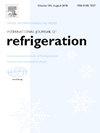比较R-134a、R-1234yf和R-600a在小型电子冷却喷雾制冷系统中的性能
IF 3.5
2区 工程技术
Q1 ENGINEERING, MECHANICAL
International Journal of Refrigeration-revue Internationale Du Froid
Pub Date : 2025-04-11
DOI:10.1016/j.ijrefrig.2025.03.048
引用次数: 0
摘要
多喷嘴喷雾冷却装置,集成了一个紧凑的,线性的,无油的R-134a压缩机,在之前的工作中介绍过,现在实验评估与R-1234yf和R-600a作为直接替代方案。该装置将蒸发器和膨胀装置的功能结合为一个装置,允许过冷的制冷剂通过一系列斜孔膨胀,形成直接撞击加热表面的喷雾。实验分析量化了冷却系统的热力学性能,包括压缩机功率和性能系数,以及稳态传热参数,如换热系数、表面温度和临界热流密度。评估考虑了制冷剂充注量、稳态应用热负荷(制冷量)和制冷剂类型的影响。为保证比较的不偏倚,在最低热负荷25w下,调整制冷剂充注量,使所有制冷剂的蒸发温度保持一致。实验测试在广泛的蒸发温度范围内进行(4.5至20.0°C)。结果表明,在选择制冷剂替代品时,传热性能和制冷系统的热力学性能之间存在权衡。在所有测试条件下,R-600a需要最低的制冷剂充注量来达到参考蒸发温度,并表现出最低的制冷剂质量流量。然而,与R-134a和R-1234yf相比,R-600a的传热性能受到了严重的影响,最大传热系数大约降低了40%。R-134a、R-1234yf和R-600a的换热系数最大值分别为42.9、43.4和25.8 kW/m2 K。本文章由计算机程序翻译,如有差异,请以英文原文为准。
Comparing the performances of R-134a, R-1234yf and R-600a in a compact spray refrigeration system for electronics cooling
The multi-jet spray cooling unit, integrated with a compact, linear, oil-free R-134a compressor introduced in previous work, is now experimentally evaluated with R-1234yf and R-600a as drop-in replacement alternatives. This unit combines the functions of the evaporator and the expansion device into a single device, allowing the subcooled refrigerant to expand through an array of oblique orifices and form a spray that directly impinges on the heated surface. The experimental analysis quantifies the cooling system thermodynamic performance, including compressor power and coefficient of performance, as well as steady-state heat transfer parameters such as heat transfer coefficient, surface temperature, and critical heat flux. The evaluation considers the influence of refrigerant charge, steady-state applied thermal load (cooling capacity), and refrigerant type. To ensure an unbiased comparison, the refrigerant charge is adjusted so that all refrigerants maintain the same evaporating temperature at the lowest thermal load of 25 W. Experimental tests are conducted across a wide range of evaporation temperatures (4.5 to 20.0 °C). The results indicate a trade-off between heat transfer performance and thermodynamic performance of the refrigeration system when selecting a refrigerant alternative. R-600a required the lowest refrigerant charge to achieve the reference evaporation temperature and exhibited the lowest refrigerant mass flow rate under all tested conditions. However, the heat transfer performance of R-600a is severely penalized compared to R-134a and R-1234yf, with approximately a 40% reduction in the maximum heat transfer coefficient. The maximum values of the heat transfer coefficient for R-134a, R-1234yf, and R-600a are 42.9, 43.4, and 25.8 kW/m K, respectively.
求助全文
通过发布文献求助,成功后即可免费获取论文全文。
去求助
来源期刊
CiteScore
7.30
自引率
12.80%
发文量
363
审稿时长
3.7 months
期刊介绍:
The International Journal of Refrigeration is published for the International Institute of Refrigeration (IIR) by Elsevier. It is essential reading for all those wishing to keep abreast of research and industrial news in refrigeration, air conditioning and associated fields. This is particularly important in these times of rapid introduction of alternative refrigerants and the emergence of new technology. The journal has published special issues on alternative refrigerants and novel topics in the field of boiling, condensation, heat pumps, food refrigeration, carbon dioxide, ammonia, hydrocarbons, magnetic refrigeration at room temperature, sorptive cooling, phase change materials and slurries, ejector technology, compressors, and solar cooling.
As well as original research papers the International Journal of Refrigeration also includes review articles, papers presented at IIR conferences, short reports and letters describing preliminary results and experimental details, and letters to the Editor on recent areas of discussion and controversy. Other features include forthcoming events, conference reports and book reviews.
Papers are published in either English or French with the IIR news section in both languages.

 求助内容:
求助内容: 应助结果提醒方式:
应助结果提醒方式:


